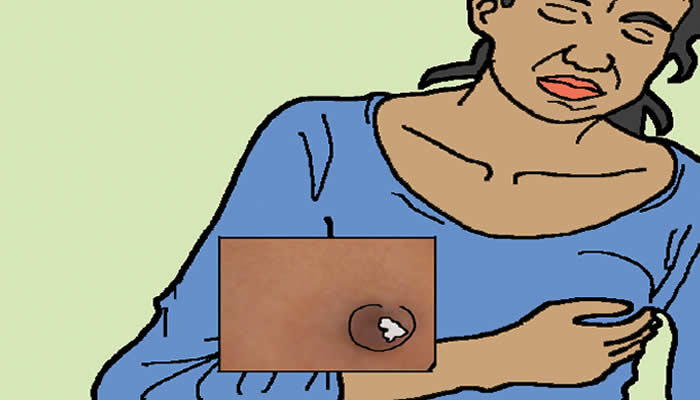
The scenario of experiencing discharge from the nipple or nipples is one that is experienced by many women around the world. It refers to any type of fluid that is seen to be coming out of the nipple and you might have to give the nipple a squeeze to produce this fluid. The liquid produced can be seen in a great variety of colours. When it is white, it could be described as normal or abnormal and it is frequently produced when the nipples are compressed. Some women who become concerned about the nature of certain breast secretions could actually cause the problem to get worse through the actions they choose to take. In a state called galactorrhoea, the discharge is milky. It is not related to pregnancy or breast feeding and is known to be caused by the abnormally high production of a hormone known as prolactin. Therefore, it is not a condition caused exclusively by a disease entity within the breasts alone but also by disease conditions in glands located elsewhere in the body. Therefore, the master gland, also called the pituitary gland is able to regulate such production of prolactin such that the nipples are stimulated to produce milk. Another gland which is similarly able to influence the production of milk is the thyroid gland.
Nipple discharge is common during the reproductive years and the discharge is usually not taken seriously unless of course it has become so voluminous and so consistent that it negatively affects the prospects of getting pregnant. At that point, it has to be treated with certain medications that are prescribed on the advice of an attending doctor. It is a common symptom and it is in most cases, part of the normal function of the breast. Such nipple discharge can also be described as cloudy and it may be produced in similar circumstances as the whitish discharge described above. If the discharge is yellow or filled with pus, it most often means that there is an infection in that breast or nipple and such a breast will have to be comprehensively evaluated to obtain the necessary antibiotic treatment. On the other hand, if a nipple discharge is clear, especially if it is coming out of just one breast, it is important to consider the possibility of it being caused by cancer. It may also be coming forth from a papilloma. Therefore, such a discharge can be the earliest symptom produced in breast cancer even when there is no definite mass that one can feel.
If a nipple discharge is brown or like cheese, it is regarded as being due to a blocked milk duct and is properly described as a mammary duct ectasia. There are several such ducts in each breast and each duct ultimately ends up in the nipple, so that they look like milk sacs inside the breast that come together in a ring containing 15-20 such points around the nipple to produce milk. We have seen above that normal discharge may be clear, white, thin or cloudy. If the discharge becomes coloured like green, bloody, yellow or brown, it is regarded as abnormal. Any such abnormal discharge will vary in appearance depending on their cause, and may be associated with other abnormalities such as redness of the skin, the formation of a dimple, swelling, the formation of a crust, the appearance of a sore or sores and the retraction of the nipple. A retracted nipple is one which pulls inwards and does not return to its normal position when it is stimulated. If a discharge occurs from one breast alone without stimulation, especially if it is bloody, it is regarded as abnormal. Therefore, if a nipple discharge persists for more than one menstrual cycle, or if any of the warning signs enumerated below are present, the woman should see a doctor.
A nipple discharge is a cause for concern when it is pink in colour or bloody. It is potentially problematic if it comes from one breast only, just as we have emphasised above. It is a problem if it is accompanied by a lump which you can easily feel. This is the reason why women are encouraged to perform their breast self-examination at least once in a month particularly when they are in the bathroom. Any lump that is felt thereby is subject to confirmation by a spouse, a female sibling or mother, after which a doctor should be consulted. It should be a cause for worry if the discharge seen at any point is spontaneous and happens without the stimulation of the nipple or breast by squeezing or otherwise. This event is concerning when it is seen in a boy or man. In boys, squeezing or pressing should be stopped once the discovery is made as such acts tend to make the problem linger. Finally, nipple discharge of any kind is a matter of concern in most women who are above the age of 50 years. In women of reproductive age, nipple discharge can be seen as part of the fibrocystic changes that occur in the breast before menstruation occurs.
In women who are in their regular cyclical pattern of the menstrual cycle, such nipple discharge is most likely to come from both nipples and the breasts are found to be lumpy and painful when touched. The discharge itself may appear dark. However, it is important to bear in mind always that the phenomenon of nipple discharge is often mediated by hormones. Some of these changes are regarded as normal, hence the elevation of prolactin leading to the production of breast milk is normal in circumstances that make the milk produced to be of use, such as during breast feeding. In the course of pregnancy, the constantly rising levels of oestrogen also causes milk production to rise in preparation for the coming baby. Certain medications may also be responsible for increased milk production. This happens when they decrease the level of dopamine in the brain. Normally, dopamine prevents the production of prolactin, but when it is reduced because of the effect of certain medicines, prolactin secretion increases and more milk is produced. Drugs used to treat depression and hypertension also have similar effects and increase the production of prolactin.
Chronic kidney or liver disease has also been found to be able to cause elevations in the amount of prolactin in the circulation thereby raising the spectre of milk production in the nipples. However, nipple discharge can regularly occur in each woman from time to time and may be regarded as normal when this is the case. Persistence is a red flag. It is a phenomenon that is sometimes seen even in babies. Nipple discharge in both male and female babies is typically made of milk and is not considered an abnormality. This often happens soon after birth and requires no treatment. Usually, this also stops within a few weeks at the most. When the features of nipple discharge are not normal like we examined in the previous two paragraphs, it is important to see a doctor where you will undergo a professional physical breast examination. Following that, an ultrasound scan of the breast is requested to determine the nature of any lumps if they are present. Depending on the age at presentation, a breast mammogram could also be requested and finally, a fine needle biopsy of any lump present should also be requested. Within a couple of weeks, all relevant results are obtained and treatment can then be offered.





